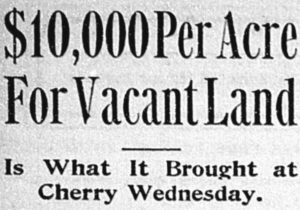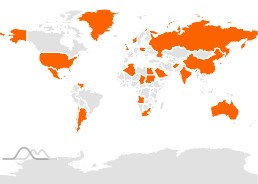On November 13, 1909, at the St. Paul Coal Company mine in Cherry, Illinois, a devastating fire trapped 300 miners, of which 259 workers, including U.S. citizens, immigrants, and children would perish. Meanwhile on campus, Illinois staff would respond to the disaster while international students raised money to help support the families of miners lost in the catastrophe.
Read on to learn more about Illinois rescue and relief fund work responses to the Cherry Mine Disaster.
As early as October of 1904, reported The Henry Republican, the recently founded town of Cherry, Illinois, was named for former Seatonville Mine superintendent Mr. James Cherry. In his new role, Mr. Cherry would become superintendent of the new Cherry Mine which was anticipated to open during the following year. Local newspapers reported that Cherry Mine building was enthusiastic and fast, with locomotive lights used to enable digging at night. By June of 1905, the Bureau County Tribune reported, plots of land for the new downtown’s Main Street had sold for $10,000 per acre, while neighboring lots were averaging $200 per acre. Such investment likely evidenced enthusiasm for money to be made from the coal mining business. It was also reported that a Joseph Schlitz Brewing Company agent had purchased local land too. Mr. Cherry would remain as the superintendent of both the Cherry Mine and the Granville Mine until his death years later in September of 1909. Following his passing, the new Cherry Mine superintendent was a Mr. James Steele, known for his previous work at the St. Paul Mine.
As difficult, hazardous work, the potentially great financial profits derive from potentially dangerous mining labor, and the Cherry Mine had its share of early accidents on site. In August 1905, in grim detail, the Bureau County Tribune recounted 27-year-old bachelor Josef Jasama whose body was mutilated when what he thought was a malfunctioning explosive had discharged as he approached it.
At the same time, in the courtroom, some railroad companies and coal mines had disagreements over how coal prices should be regulated, and in August 1906, a Danville court judge had ruled in favor of coal mines. Meanwhile, Cherry Mine coal extraction continued to increase. By the following year, in August 1907, it was even reported that the Cherry Mine was outperforming other Northern Illinois mine extractions for the first time. But just two years later, tragedy would happen.
It was Saturday, November 13, 1909, when a stable fire had broken out, trapping as many as 300 to 310 workers in the mine. Firefighting equipment was rushed to Cherry via train lines. Newspapers reported that the fire had begun in the underground stables and spread through the tunnels. As rescue workers and inspectors first descended the mine to search for the miners, fire had continued to burn in the stables and the area was closed off with steel beams and sand. Two days later, it was reported that those on the scene no longer anticipated being able to save any of the miners. While the miners could not be reached, they were presumed to be deep in the tunnels where the last remaining air might be. At night, the tunnels had been sealed to help smother the fire, which upset family members and other onlookers while state militia companies from Galesburg and Kewanee kept guard over the mine.
Part of the early rescue work was carried out by staff of the University of Illinois Mine Rescue Station. As the Daily Illini reported, on Saturday night, rescue station director R. I. Williams and his assistant W. H. Webb were contacted by telegram and they boarded the next train. By Sunday morning, they were on the scene with extra oxygen helmets to distribute to volunteers on site. By Wednesday morning, newspaper editorial staff described the scene and its impact on campus communities. On December 1, a longer account of the heroic work of Mr. Williams and Mr. Webb were recounted for readers. In January, a substantial Congressional appropriation to mine rescue units like the one at Illinois was funded.
At the time of the disaster, other local reporting discussed the financial arrangements of the miners and their dependents. It was reported that while the St. Paul Coal Company would pay for miner burials, the Mine Workers Union would provide financial compensation too. Meanwhile, until they were later dispelled by authorities, local rumors began to spread that some people thought that they could hear explosions and gun shots from the inside of the mine. By Saturday evening, it was reported that the first eight bodies were recovered as the families of some miners began to arrive on site.
By November 16, a firefighting apparatus had arrived from Chicago while the mine’s recent gaseous odor was sufficient evidence to support the idea that the fire had likely passed beyond the stables and it likely reached the coal deposits. Local news descriptions considered that not only were the miners hungry, tired, and running out of air in the heat, but they were also in the dark. At the same time, U.S. Geological Survey field director George F. Rice was busy working all night at installing a sprinkler system in the mine. Also on site was the National Red Cross director E. P. Bicknell who was to assist with organizing charitable efforts.
Meanwhile, Illinois Governor Charles S. Deneen issued an appeal for contributions to the relief of the miners and it was heard across the state including the University campus. The Governor provided the inaugural donation of $100 to the National Red Cross relief drive for Cherry Mine Disaster families. On campus, the international student organization Cosmopolitan Club (Record Series 41/64/8) led the fund raising with club member and Chinese Illini C. C Wang as treasurer. Within two days, the club had collected as much as $273.97. Off campus, other relief fund raising groups included the Urbana Baptist Church, the Cooking Club of Urbana, and Masons Lodge 57.
The generosity and the timeliness of the the relief fund work was important, because many families would not receive benefits for months or longer. As late as March 1910, the Urbana Daily Courier reported, fifty claims of widows or other relatives of the miners were settled with the St. Paul Mining Company averaging between $800 and $1200, while another 100 claims were to be settled next. Later reports calculated average family settlements to be about $1473 per claim. Thirteen of the miners were posthumously awarded Carnegie hero fund commission medals and their survivors received a modest pension to support themselves. To the surprise of the bereaved, as it was later reported in the Urbana Courier, a few unprincipled lawyers were attempting to claim the prize money for themselves. Meanwhile in Bureau County, the County itself would be burdened with the financial and staff resources strain on the county’s coroner office services. Later Cherry Mine court cases in nearby Ladd were delayed when a local smallpox outbreak had exposed jurors and witnesses to the disease. During March 1910, the fire was still burning and the final remaining miners’ bodies could not be recovered until later that month.
For the next few years, annual memorials to the Cherry Mine workers were organized. For the first anniversary, in November 1911, the United Mine Workers of Illinois had a memorial mine shaft erected to the miners and it was installed at the Cherry Cemetery. In 1912, area mine activities were suspended and addresses were made at the memorial. In 1914, both the United Mine Workers of America secretary treasurer Duncan McDonald and the vice president Adolph Germer were in attendance.
After the disaster had passed, the events would also continue to be remembered locally. In December 1909, the Geology Journal Club hosted Mine Rescue Station director Mr. Williams for a talk about his work at the Cherry mine. In January 1910, as part of the Stockmen’s and Corn Grower’s convention hosted on campus, Mr. Williams was invited to give a mine rescue apparatus demonstration. On March 13, 1910, Professor Graham Taylor gave a talk, “Heroes of the Cherry Mine”. In December, in Urbana at the Varsity Theater, a slideshow and lecture was organized. While during the following year, in Illinois magazine, an eye witness for rescue efforts at the Cherry Mine, Mining Professor Harry Harkness Stoek was also invited to write an essay to remember the disaster and its rescue work.
Got something to donate to the story so far? We’d like to hear from you! Please send us a message, leave a comment below, or contact us through social media. We and our readers would like to read about it.
References
[] For even more information on the Cherry Mine Disaster, a full report was published by the U.S. Department of Labor Statistics in 1910 and the Fire Service Institute has a comprehensive guide too. Be sure to check them out!









